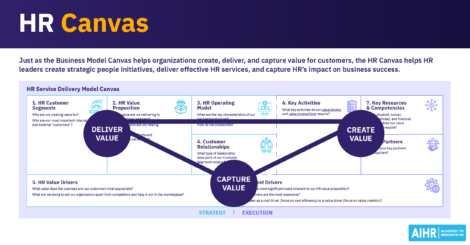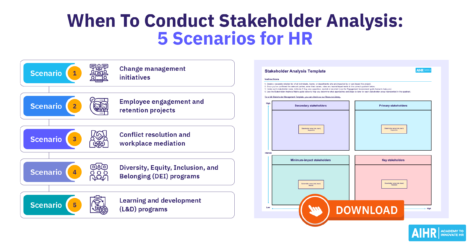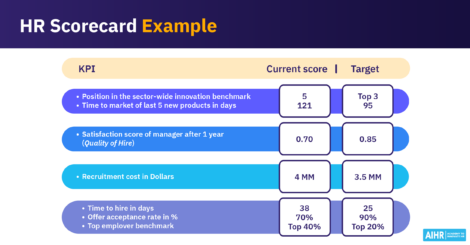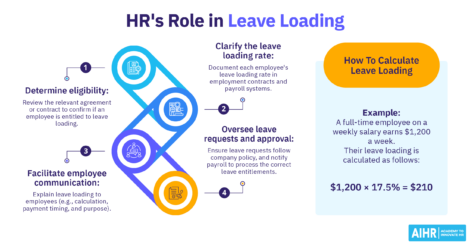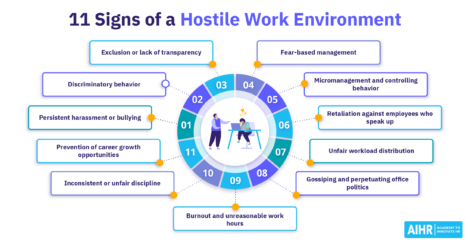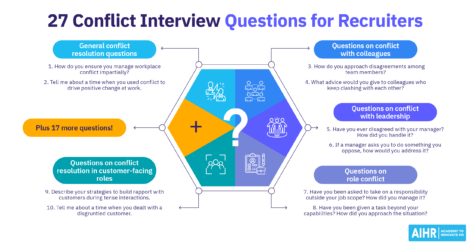Who Does HR Report To? 5 Options [With Pros & Cons]
Who HR reports to matters. Reporting structures elevate or diminish HR’s power and impact. Choosing the right one isn’t just a logistical decision — it’s a statement about the organization’s priorities, culture, and long-term vision.

In 61% of organizations, the head of HR reports directly to the CEO, president, or owner. A smaller proportion reports to the CFO (13%) or COO (10%). The fact that HR predominantly reports to CEOs reflects the significant value employers place on human resources in today’s workplaces and that who HR reports to within an organizational hierarchy can impact the entire department’s effectiveness and influence.
Whether HR reports to the CEO, CFO, COO, general counsel, or the Board of Directors, each structure carries distinct implications for strategic alignment, decision-making, and workforce management. Let’s take a closer look at each HR reporting structure.
Contents
The importance of HR reporting structures
What organizations should consider when selecting a reporting structure
5 common HR reporting structures
Determining the right HR reporting structure
FAQ
The importance of HR reporting structures
HR reporting structures are not just administrative; they are strategic choices that define how effectively an organization manages its people. The HR reporting line determines its influence on decision-making, alignment with organizational goals, and ability to respond to workforce needs.
When HR reports directly to the CEO, it elevates the department to a strategic role, integrating people management with the company’s vision and long-term goals. This arrangement empowers HR to contribute to leadership discussions, drive cultural initiatives, and advocate for employees, nurturing a thriving workplace.
On the other hand, reporting to the CFO or COO may align HR with financial efficiency or operational excellence but risk deprioritizing employee engagement and long-term strategies,
An HR reporting structure reflects organizational values. It sends a clear message about whether the company prioritizes people, processes, or profits — and balancing these priorities is essential for sustainable growth and innovation.
What organizations should consider when selecting a reporting structure
When creating or redesigning HR reporting structures, organizations must evaluate their unique needs, priorities, and culture. Key considerations include:
- HR’s role in the organization:
- Is HR a strategic partner driving business outcomes?
- Or is it primarily operational, focusing on compliance and workforce management?
- Leadership alignment:
- Would reporting directly to the CEO amplify HR’s impact?
- Would alignment under the COO better support the business model?
- Industry, size & complexity:
- Multinational corporations may need regional flexibility in their HR structure.
- Smaller businesses might prioritize streamlined decision-making and agility.
- Ensuring HR’s authority & resources:
- The structure should enable HR to effectively engage employees.
- It should support innovation, resilience, and long-term business success.
5 common HR reporting structures
When it comes to structuring HR’s reporting lines, organizations have various approaches depending on their priorities, culture, and strategic goals.
Each reporting structure carries distinct advantages and challenges, influencing how HR impacts decision-making, employee engagement, and operational efficiency. From reporting to the CEO for strategic alignment to aligning with the CFO for financial precision, these models illustrate the diversity in HR’s role within businesses.
1. HR reporting to the CEO
The HR department reports directly to the CEO, directly connecting workforce strategy and top leadership. This structure positions HR as a key strategic function rather than just an administrative department, enabling human capital decisions at the highest level.
- Fast top-level strategic decisions: HR has direct input on executive decisions, allowing
for quick alignment with business goals.
- Strong influence on business direction: HR helps shape culture, workforce planning, and leadership strategy at the highest level.
- Elevated organizational status: HR is seen
as a strategic function, not just an administrative role. - Direct access to resources: HR priorities get greater visibility and potential budget approval faster.
- Clear commitment to workforce strategy: Signals that people, culture, and talent development are core business priorities.
- Less focus on daily operations: HR may be less involved in frontline workforce management, leading to gaps in execution.
- CEO bandwidth constraints limit effectiveness: If the CEO has too many priorities, HR may struggle to get sufficient attention.
- Distance from departmental needs: HR may be less connected to individual business units, impacting practical HR implementation.
- Strategic overemphasis versus administration: A focus on long-term HR strategy might come at the expense of
day-to-day HR functions.
Reporting to the CEO in action
Amazon
Beth Galletti, Senior Vice President of Human Resources, reports directly to Amazon’s President and CEO.
Amazon’s decision to position the Senior Vice President of Human Resources as a direct report to the President and CEO reveals the company’s strategic emphasis on its workforce as a critical driver of success.
By integrating HR at the highest executive level, Amazon ensures people management aligns with its business strategy and leadership vision. This structure lets HR shape the company’s culture, drive innovation, and support rapid growth, evidenced by its ability to scale operations globally while maintaining high employee satisfaction.
It signals to employees and stakeholders that human capital is a core priority, positioning HR not as an administrative function but as a strategic enabler of Amazon’s dominance in the technology and e-commerce sectors.
The Chief People Officer at Google reports directly to the CEO. Fiona Cicconi, who joined as Chief People Officer in January 2021, reports to CEO Sundar Pichai. This structure reflects Google’s emphasis on human resources and talent management at the highest level.
Google’s organizational structure emphasizes a flat hierarchy and cross-functional teams, operating under a matrix structure for high collaboration and knowledge sharing. This approach aligns with the Chief People Officer’s direct reporting to the CEO, highlighting the strategic importance of HR in Google’s operations and decision-making.
Empower your HR team to work with confidence
Who HR reports to can shape an organization’s strategy, compliance, and culture. No matter where HR sits in your company, one thing is clear—HR professionals need the right skills to drive business impact.
With AIHR for Teams, your HR professionals gain access to cutting-edge training that helps them enhance decision-making, streamline HR processes, and implement strategic initiatives. Equip your team with the knowledge they need to elevate HR’s role in your organization.
2. HR reporting to the CFO
The HR department reports to the Chief Financial Officer, creating a structure where workforce management aligns closely with financial oversight and resource allocation. This positions HR within the broader context of organizational costs and investments, emphasizing the financial impact of human capital decisions.
However, this arrangement might imply that people are viewed as the company’s biggest expense, with a focus on headcount and bottom-line considerations.
While HR reporting to the CFO occurs in many industries, it’s not a preferred structure. Many organizations are moving toward HR reporting directly to the CEO, reflecting the growing strategic importance of human resources. Industries like tech, healthcare, and finance value HR highly, preferring direct reporting to the CEO.
- Tight control over personnel costs: Workforce expenses, including salaries, benefits, and hiring, are carefully monitored and optimized, ensuring cost efficiency.
- Data-driven workforce planning decisions: HR decisions are based on financial analytics, workforce data, and forecasting models,
leading to more measurable, objective hiring and compensation strategies. - Strong budget alignment: HR initiatives, from hiring to training programs, are designed with financial sustainability in mind, reducing the
risk of overspending. - Clear ROI focus: HR investments, such as compensation structures, employee development, and retention programs, are evaluated based on their financial return, ensuring that expenditures contribute to business goals.
- Efficient resource allocation: Payroll,
benefits, and HR technology investments are aligned with financial priorities, improving
cost-effectiveness and operational efficiency.
- Overemphasis on financial metrics: HR decisions may be driven by spreadsheets and cost-cutting goals rather than long-term employee engagement and organizational culture.
- Limited focus on strategic people initiatives: With HR positioned under finance, talent development, DEIB, and culture-building efforts may take a backseat to cost considerations.
- Cost may override talent needs: Budget restrictions may lead to underinvestment in recruitment, training, and employee wellbeing programs, impacting long-term retention and performance.
- Reduced power of people advocacy: HR may have less influence in pushing for employee benefits, salary increases, and workplace policies that prioritize people over profits.
- Finance-first culture dominates HR: Employees may feel dehumanized if HR functions as an extension of financial oversight rather than an advocate for workforce wellbeing. This can lead to lower morale and engagement.
Reporting to the CFO in action
A mid-sized manufacturing company
In a hypothetical mid-sized manufacturing firm focused on operational efficiency and cost management, the HR Director reports directly to the CFO. This structure aligns with the company’s focus on cost control and ensures that HR strategies, like workforce planning and benefits management, are integrated with financial goals.
The CFO and HR Director collaborate to monitor labor costs, optimize employee productivity, and assess the ROI of training programs. This reporting line ensures financial insights inform talent acquisition and retention strategies, supporting a cost-effective approach to workforce management.
A retail chain with seasonal demand
In this illustrative example, a retail chain with significant seasonal hiring demands has its Chief HR Officer report to the CFO. This structure ensures that decisions about temporary staffing, overtime pay, and benefits during peak periods are driven by sound financial analysis, given the financial complexities of managing fluctuating labor needs. By working closely with the CFO, the HR team can develop scalable staffing models and forecast hiring budgets that align with the company’s revenue projections.
3. HR reporting to the COO
In this setup, the HR department reports to the Chief Operating Officer, creating an integrated approach where workforce management is tied to operational effectiveness and daily business execution. This structure positions HR as a key enabler of operational excellence, linking workforce management to business performance and operational goals.
This structure may occur when people are considered the company’s ‘building blocks’, focusing on urgent resource needs for product or service delivery.
- Strong alignment of operational processes: Workforce management is positioned to directly support business needs in real time.
- Quick execution of initiatives: Operational HR decisions are implemented rapidly without excessive approval layers.
- Close to business realities: HR stays connected to department needs, ensuring policies are practical and relevant.
- Focus on practical implementation: Instead of being overly policy-driven, HR prioritizes actionable solutions, such as improving shift scheduling and optimizing labor allocation.
- Direct impact on operations: HR contributes to efficiency, productivity, and service delivery goals, and ultimately, to bottom-line success.
- Limited strategic influence: HR focuses more on execution than long-term workforce planning.
- Operations supersede people’s needs: Workforce decisions may prioritize efficiency over employee wellbeing.
- Reduced executive visibility: HR may have less influence in shaping company-wide policies.
- Planning is dominated by short-term focus: Immediate staffing needs may overshadow workforce and leadership development and future planning.
- Less authority for organizational change: HR may lack decision-making power in company-wide transformations.
Reporting to the COO in action
A mid-sized manufacturing firm undergoing rapid growth
An illustrative example of an HR Chief Operating Officer (HR COO) reporting to the Chief Operating Officer (COO) can be a mid-sized manufacturing firm undergoing rapid growth. The HR COO is tasked with streamlining HR service delivery to support the company’s strategic goals, such as workforce scalability, compliance during international expansion, and integrating advanced HR technologies.
Reporting directly to the COO ensures the HR COO is aligned with the company’s operational priorities, enabling a unified approach to enhancing employee experience while driving cost-efficiency and agility.
According to Deloitte’s research, this reporting structure is valuable in organizations facing complex operational challenges requiring HR’s critical role. During a global merger, the HR COO can oversee the harmonization of HR policies, ensuring seamless workforce integration while maintaining compliance and morale.
With a direct line to the COO, the HR COO can advocate for HR’s operational needs in high-level decision-making, ensuring people strategies align with business objectives. This partnership transforms HR into a dynamic driver, improving organizational effectiveness and responsiveness in a competitive environment.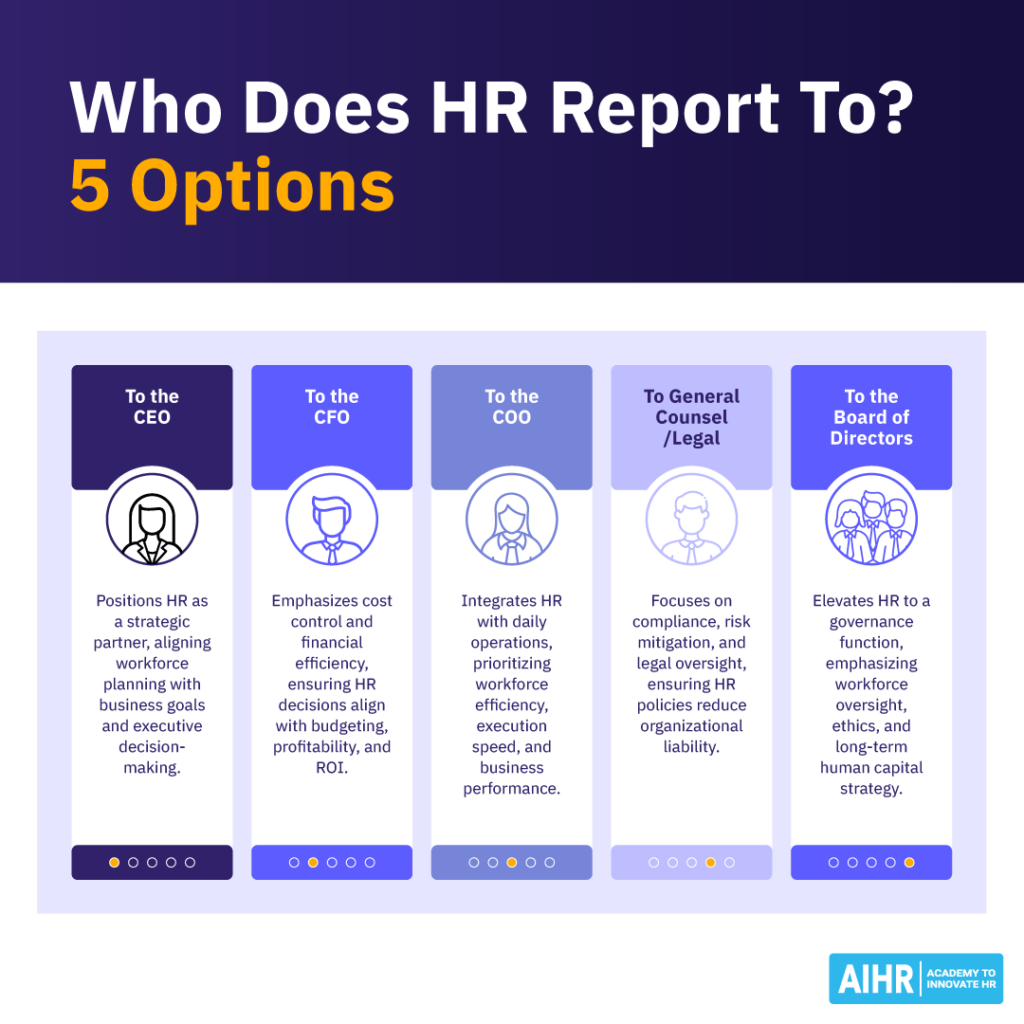
4. HR reporting to General Counsel/Legal
The HR department reports to the General Counsel or Legal department, aligning employee management with legal compliance and risk management. This positions HR with a strong focus on employment law, regulatory requirements, and protecting the organization from workforce-related legal exposure.
HR reporting to the General Counsel can help mitigate legal risks and ensure compliance with employment laws and regulations. When HR reports to the General Counsel, it may indicate the organization views people as its biggest liability, emphasizing risk aversion and policy administration. In most cases, HR closely collaborates with General Counsel — it does not report directly to them.
According to the ACC Chief Legal Officer Survey, about 77% of General Counsels report directly to the CEO. This suggests that both HR and Legal are usually separate functions working together that report to the CEO rather than one reporting to the other.
The collaboration between HR and legal is increasingly important in diversity, social justice, and employee relations. The General Counsel often has access to all material information, putting them in a unique position to protect the company’s interests in HR matters.
- Strong focus on legal compliance: HR policies and decisions align closely with employment laws and regulatory requirements.
- Risk-mitigation decisions: Workforce management prioritizes reducing legal risks
and avoiding costly disputes. - Clear policy enforcement structure: Workplace policies are consistently applied to maintain compliance.
- Protected communication channels: HR gains legal privilege in certain matters, strengthening confidentiality in sensitive cases.
- Expert employment law guidance: HR benefits from direct access to legal expertise, improving policy accuracy and risk assessment.
- Over-emphasis on legal risks: HR may prioritize policy enforcement over employee experience and workplace culture.
- Limited focus on people development: Leadership training, career growth, and engagement may take a backseat to risk management.
- A conservative approach limits innovation: A legal-first mindset can stifle progressive HR initiatives in talent management, DEI, and workplace flexibility.
- Reduced strategic business influence: HR may be viewed as a compliance function rather than a key driver of business success.
- Compliance overshadows engagement needs: Strict adherence to regulations may reduce focus on employee satisfaction and retention strategies.
Reporting to General Counsel in action
A multinational corporation
In a multinational corporation navigating complex regulatory environments, the HR department collaborates closely with the General Counsel to ensure compliance and nurture a positive employee experience. This partnership is vital when addressing diversity, equity, and inclusion (DEI) matters, where legal considerations intersect with HR policies. By working together, HR and the GC can develop and implement DEI initiatives that comply with legal standards and promote inclusivity, enhancing employee satisfaction and retention.
During organizational changes like mergers or acquisitions, collaboration between HR and the GC becomes crucial. The GC provides legal insights into contractual obligations and compliance, while HR manages employee communications and integration. This joint effort ensures smooth transitions, mitigating legal risks and maintaining workforce morale. Strategic alliances between HR and the GC are essential in aligning legal frameworks with human capital strategies, contributing to the organization’s stability and growth.
A global retail company
In a global retail company, HR and the General Counsel work closely to address compliance with labor laws across multiple jurisdictions. During the roll-out of a hybrid work policy, HR collaborates with the General Counsel to ensure alignment with regional employment regulations, data privacy laws, and workplace safety requirements.
While HR leads policy development and employee communications, the General Counsel reviews them for legal soundness, ensuring compliance and mitigating risks. This collaboration results in a policy that balances employee flexibility with the company’s legal obligations.
These collaborations are crucial in workplace investigations or employee disputes. If an employee raises a discrimination complaint, HR manages the internal investigation and employee relations, while the General Counsel ensures adherence to legal protocols, protects attorney-client privilege, and prepares for potential litigation.
By working together, HR and the General Counsel create a unified approach to sensitive issues, building trust and safeguarding the organization from legal and reputational risks. However, while this partnership strengthens organizational resilience and enhances the employee experience through fair and compliant practices, it is not a direct reporting structure.
5. HR reporting to the Board of Directors
The HR department reports directly to the Board of Directors, creating a unique governance structure where workforce management is overseen at the highest organizational level. This positions HR as a critical governance function, emphasizing workforce oversight and strategic human capital management as key board responsibilities.
Reporting to the board can elevate HR’s strategic importance and ensure people-related issues are considered at the highest level of decision-making.
- Highest-level strategic oversight: HR policies and workforce planning are aligned with long-term business strategy at the board level.
- Independent from executive management: HR maintains autonomy, ensuring unbiased decision-making in leadership evaluations, executive compensation, and workforce policies.
- Strong governance and accountability: Workforce management becomes a core governance function, reinforcing transparency and ethical decision-making.
- Direct connection to shareholder value: HR’s influence extends beyond internal operations, aligning talent strategy with investor and business priorities.
- Maximum authority for change: HR has the power to drive large-scale organizational transformations, such as leadership restructuring and culture shifts.
- Disconnect from daily operations: HR may lose sight of frontline workforce challenges due to its high-level oversight role.
- Complex decision-making processes: Board-level approvals may slow down workforce initiatives, delaying policy implementation.
- Limited operational effectiveness: With no direct link to functional leadership, HR may struggle to execute practical, day-to-day workforce management tasks.
- Board engagement time constraints: The board’s infrequent meetings and broad responsibilities can limit its focus on HR-specific needs.
- Distance from employee needs: HR’s direct connection to employees may weaken, as decision-making is centered on governance and corporate priorities rather than workplace experience.
Reporting to Board of Directors in action
Wells Fargo
At Wells Fargo, the HR function is led by Bei Ling, the Senior Executive Vice President and Head of Human Resources. She serves on the company’s Operating Committee and is responsible for its human capital strategy. She works closely with leaders across Wells Fargo’s global footprint to build a world-class culture and support an inclusive environment.
The HR function reports to the Board of Directors through the Human Resources Committee (HRC). The HRC assists the Board in overseeing the company’s compensation strategy and senior executives’ compensation. The committee’s responsibilities include reviewing and approving compensation policies, incentive plans, and succession planning for key leadership roles.
This reporting structure aligns HR strategies and practices with the company’s objectives and regulatory requirements while promoting transparency and accountability in human capital management.
Determining the right HR reporting structure
Choosing the ideal HR reporting structure requires a thoughtful evaluation of various organizational factors. The structure must align with the company’s strategic goals, culture, and leadership dynamics while balancing industry standards and operational realities.
It’s not just about where HR fits in the hierarchy — it’s about how it supports employee advocacy, drives strategic initiatives, and bolsters organizational resilience. Here are some key considerations for determining the most effective HR reporting structure:
Organizational message and culture
- Strategic alignment: Decide what reporting structure best communicates the organization’s priorities (e.g., whether HR is seen as a strategic partner or an administrative function).
- Visibility: Consider if the structure elevates HR’s role, signaling its importance in decision-making.
- Employee trust: Ensure the structure supports a culture of transparency, fairness, and employee advocacy.
Organizational priorities
- Business goals: Align the HR structure with the company’s short- and long-term goals, such as growth, innovation, or operational efficiency.
- Change management: Reflect on how the structure can support ongoing or upcoming transformations (e.g., digital transformation, mergers).
- Resource allocation: Determine how HR can effectively manage resources like talent acquisition, employee engagement, and retention.
Industry standards
- Benchmarking: Compare HR reporting structures with industry peers to ensure competitiveness.
- Compliance and regulation: Consider legal or regulatory requirements that may influence HR’s organizational hierarchy.
- Best practices: Leverage industry trends, like having CHROs report directly to the CEO, to keep HR relevant and impactful.
Leadership dynamics
- Leadership vision: Assess the relationship between HR leaders and the executive team. Does the structure support collaboration and influence?
- CEO involvement: Determine if direct reporting to the CEO would enhance HR’s strategic role.
- Span of control: Evaluate the capacity and focus of the leader (e.g., COO, CFO, or CEO) to whom HR reports and their ability to advocate for HR initiatives.
Organizational structure
- Centralization vs. decentralization: Decide if HR functions should be centralized for consistency or decentralized for flexibility.
- Global considerations: For multinational organizations, consider how HR should report across regions or subsidiaries.
- Size and complexity: Larger organizations with complex hierarchies may require more layered reporting structures.
Strategic HR capabilities
- HR’s role: Define whether HR is primarily strategic, operational, or a blend of both.
- Data and analytics: Ensure the reporting structure supports HR’s ability to contribute to data-driven decisions.
- Innovation: Position HR to lead or support DEI, wellness, and employee experience initiatives.
Employee impact
- Accessibility: Ensure the structure promotes accessibility for employees seeking HR support.
- Engagement: Consider how the structure impacts HR’s ability to foster engagement, morale, and productivity.
- Accountability: Evaluate whether the structure enhances accountability in addressing employee concerns.
Flexibility and scalability
- Adaptability: Choose a structure that can evolve with organizational growth or strategy changes.
- Crisis readiness: Ensure HR can respond effectively to challenges like economic downturns or crises.
All in all: Who should HR report to?
The decision of who HR should report to is crucial, as it shapes the department’s ability to influence organizational success. While each HR reporting structure offers unique benefits, reporting directly to the CEO is often the most advantageous for organizations aiming to position HR as a strategic driver. This structure ensures HR has a direct line to leadership, elevating its influence on decisions that shape company culture, drive innovation, and align workforce strategies with business goals.
However, the optimal reporting structure ultimately depends on the organization’s specific needs, size, industry, and strategic priorities. By carefully evaluating these factors, businesses can implement a structure that maximizes HR’s impact, building and supporting a resilient, engaged, and future-ready workforce.
FAQ
The position varies depending on the company’s reporting structure. Depending on the organization’s priorities, HR may report directly to the CEO, CFO, COO, General Counsel, or the Board of Directors.
Yes, in some organizations, HR reports to the Chief Operating Officer. This structure ties HR closely to day-to-day operations, ensuring workforce management aligns with operational goals.
In organizations where HR reports to the COO, it often functions as part of Operations. This approach emphasizes integrating HR practices with business execution and operational efficiency.
HR reporting to the CEO is generally preferable, as it positions HR as a strategic partner in decision-making and elevates its influence on organizational priorities. However, reporting to the COO may be better for organizations with a strong operational focus.
The oversight depends on the company’s structure. It could be the CEO, CFO, COO, General Counsel, or the Board of Directors, each bringing a unique perspective and emphasis to the department’s priorities.
Learn more
Related articles
Are you ready for the future of HR?
Learn modern and relevant HR skills, online







